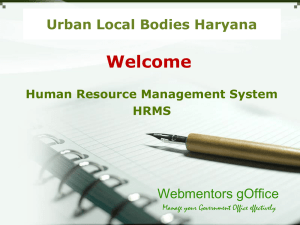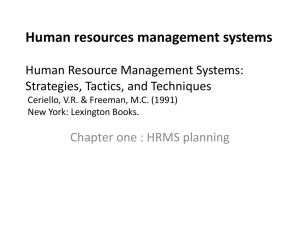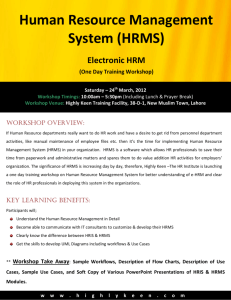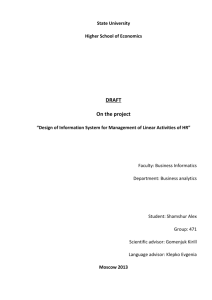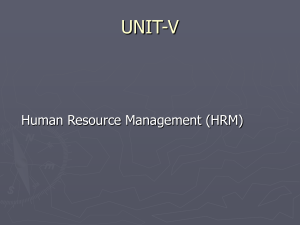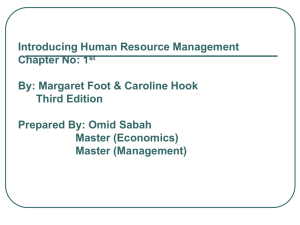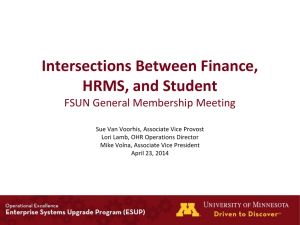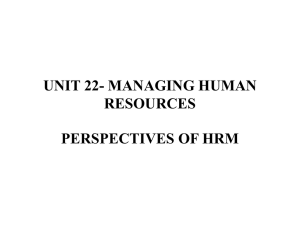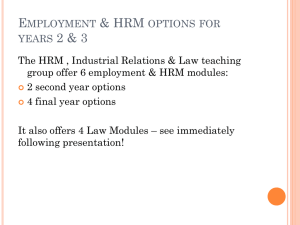- Everyday Leadership
advertisement
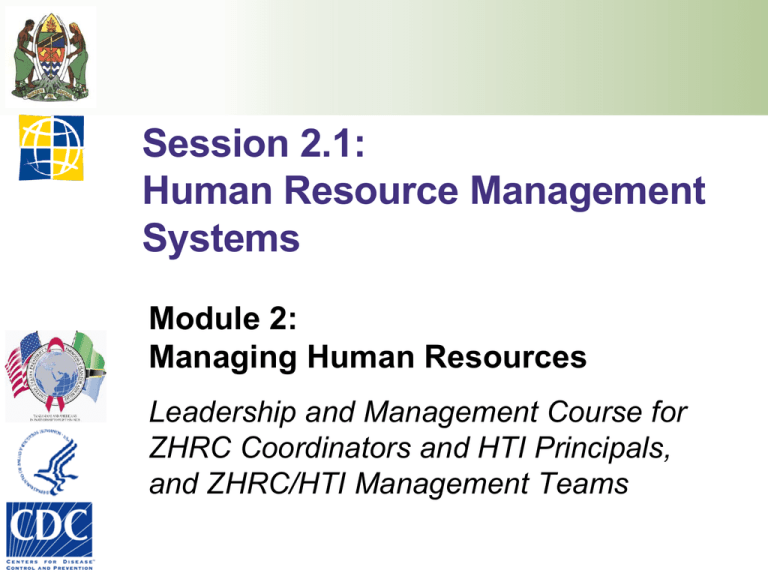
Session 2.1: Human Resource Management Systems Module 2: Managing Human Resources Leadership and Management Course for ZHRC Coordinators and HTI Principals, and ZHRC/HTI Management Teams Learning Objectives By the end of the session, participants will be able to: Identify areas for improvement in their human resource management system (HRMS). List key benefits of an effective HRMS. Describe the components of HRMS. Describe the elements of a performance management system. Identify opportunities to integrate professional development into the HRMS. 2 Activity: HRMS True or False Exercise Listen to the statements about Human Resource Management (HRM). Stand up if you think the statement is true. Sit down if you think the statement is false. 3 What is “human resource management”? 4 Human Resource Management The integrated use of systems, policies, and management practices to recruit, maintain, and develop employees to support the organization in meeting its desired goals. - Management Sciences for Health, 2009 The formal structure within an organization responsible for all the decisions, strategies, factors, principles, operations, practices, functions, activities, and methods related to the management of people. -International Society for Human Resource Management/ Capacity Project, 2006 5 Activity: HRMS Quick Assessment Use Worksheet 2.1.2 Work on your own to complete Part 1: Assessment. Work in small groups to complete Part 2: Identifying Areas for Improvement. • Compare and discuss the results of your assessment in your group. • Identify priority areas for improvement in your current HRMS. 6 HRM Activities Establish, maintain, implement, and promote: • Systems, policies, and practice to address employment terms and conditions • Fair compensation system • Performance planning and review system • Employee data systems and personnel files • Training strategy linked to organizational goals • Strategies for meeting future staffing needs • Stable and supportive work environment • Practices which foster trust and respect 7 Benefits of Effective HRMS Improved Capacity Organizational Alignment Systematic Planning Manage Change Role/Job Clarity Cost Savings Equity in Compensation Defined Support Levels Tap into Skills & Knowledge 8 Components of HRMS 1. Capacity 6. Data 5. Training 2. HR Planning HRMS 3. Personnel Policy/Practices 4. Performance Management 9 HRM Component 1: Capacity HRM capacity begins with staffing and budgeting. HRM Budget • Allows for consistent planning • Relates costs to results • Includes personnel costs, overhead expenditures HR Staff • Experienced staff dedicated to HRM • Essential to policy development, implementation, and long-range strategic planning 10 HRM Component 2: HR Planning Allows efficient use of HRM resources to support mission and goals • People are an organization’s most valuable asset! Aims for optimal use of current workforce Attempts to meet short- and long-term staffing needs Ensures that HR policies support recruitment and retention of qualified staff • Training requirements for new and existing staff • Formal salary scale for each job category • System for salary upgrades and merit awards 11 HRM Component 3: Personnel Policies and Practices Framework to define terms and conditions of work Foundation for supervision and performance management systems • • • • • Job Classification System Compensation System Benefits Program Staff Retention Recruitment, Hiring, Transfer, & Promotion • Non-Discrimination Policies • Orientation Program • HIV/AIDS Workplace Prevention Program • Employee Manual • Discipline, Grievance, & Termination Procedures • Relationship with Unions • Labor Law Compliance 12 HRM Component 4: Performance Management Includes job descriptions, and systems for supervision, work planning and performance review Defines how people will interact with each other, how the work supports the organization’s goals Job Descriptions • Describe what employees do, how they work with each other, and their positions in the organization • Should be reviewed and updated regularly, as organisation grows and changes. 13 Performance Management, cont’d Staff Supervision • System for supervisor and employee to jointly monitor performance • May involve professional development • HR can offer training in supervisory skills Work Planning & Performance Review • Work plans and performance objectives should be jointly developed with employee & supervisor • Performance reviews utilize work plans & objectives • OPRAS is central to this process, and shows individual contributions toward organization’s goals 14 HRM Component 5: Training Identify Training Needs • Focus on individuals, groups/teams, or organization • Assess needs by soliciting information, observing staff, and studying data • Surveys, interviews, checklists, customer/client responses, employee records, policy reviews, future trends/opportunities analysis, etc. Staff Training • Develops staff and organizational capacity • Addresses gaps in knowledge, skills, & performance • Improves motivation, morale, & commitment 15 Training, cont’d Management & Leadership Development • Key for sustainability • Help to address organizational challenges • Develop management & leadership skills at all levels • Prepare for leadership succession Links to External Training • Pre-service or In-service training based on skills needed in the workplace • Allows up-grading of skills and knowledge 16 HRM Component 6: Data Organizations need data to track staff, and to project employment needs. Data supports all other components of HRMS Employee Tracking System • Captures basic information about staff • Number of staff, position location, salary level, year of hire gender, age, rate of attrition & absenteeism • Data should be up-to-date and readily available • These data inform HR planning processes 17 Data, cont’d Personnel Files • Essential data on employee work history • Track individual employee performance, promotion, salary history • Require policies on confidentiality, employee access Computerization of Data • Accessible, accurate, and timely data is essential for good planning • Many electronic systems simplify HRMS data collection • Managers should update databases regularly 18 Employee-Responsive HRMS A well-planned and implemented HRMS improves staff performance and motivation. An employee-responsive HRMS addresses key concerns: • Am I being treated fairly? • What am I supposed to do? • How well am I doing my job? • Does my work matter? • How can I develop within this organization? 19 Workforce Planning A workforce plan focuses on ensuring an adequate number of staff with appropriate skills, who are available, where and when they are needed. Based on assumptions & predictions about future • Expectations of growth, increased demands, etc. • Short-term and long-term (1, 5, 10, 20 years, etc.) Relies heavily on existing HRMS data. Conducted annually and reviewed regularly Should include stakeholders in planning processes 20 Steps in Forecasting Supply and Demand 1. Determine requirements/demand • 2. 3. 4. 5. Number, type, and location of staff needed Analyze current supply Estimate losses/attrition Calculate future needs Plan for Replacement and Recruitment • • Developing existing staff (internal) Recruitment of new staff (external) 21 Performance Management System Sets performance standards to reflect mission, strategic plans, operational plans Answers three key questions: • What am I supposed to be doing? • How well am I doing it? • Does it matter to the organization? 22 Advantages of Performance Management System Reinforces organizational goals & priorities Communicates the organization’s work values Defines the work that each person does, and how it relates to the organizational mission Provides information on expected level of performance Provides information about performance, and how it influences compensation decisions 23 Elements of Performance Management (PM) System 1. Current job descriptions 2. Effective supervisory system 3. System for periodic performance planning and review for each employee 4. Means for identifying and addressing staff training and development needs 24 PM Element 1: Job Descriptions Job Descriptions are used for • Hiring, Orientation, Supervision & Performance Review, Operations, Salary Key Elements of a Job Description • • • • • Job title, post or location, supervisor Date the job description was developed Summary Job Duties • Description of all employee responsibilities • Divided into major areas of responsibility Skills & Qualifications Required 25 PM Element 2: Supervisory System Effective supervisors are the key to a successful performance management system. A supervisory system provides: • Foundation for performance management • Bridge between the organization and the employee • Communication of organizational goals and priorities • Guidance on how work supports goals • Capacity and skill development to do the work • Tools for accountability and performance assessment 26 PM Element 3: Planning and Review System Organizational processes should be standardized Standard Documentation • Employee’s name, title, duty station, supervisor, date and signature spaces Performance Plan and Performance Review sections • Discussed and completed by supervisor and employee Open Performance Review and Appraisal System (OPRAS) provides standard guidance 27 Planning and Review System, cont’d. Performance Plans • Performance objectives • Supervisor action plan • Development plan Performance Reviews • Achievement of objectives • Overall performance • Supervision & communication 28 PM Element 4: Training & Development Investing in training & development can: • Help new staff develop skills, master protocols, and understand expectations • Strengthen skills of current staff • Address gaps in performance • Improve staff motivation and retention Training is appropriate only when performance problems result from lack of skill. • Alternatives include other professional development activities, improved supervision, changing incentives, etc. 29 Training & Development, cont’d Managers help to determine when and what type of training is needed to address performance gaps. • Formal, Informal, or Refresher Training • Challenging assignments, structured on-the-job learning, mentoring, rotational assignments, etc. 30 How do we grow professionally? The five most impactful ways that we grow professionally are: 1. 2. 3. 4. 5. Challenging assignments Activities away from work Supervision & Mentoring (i.e., one’s boss) Learning through setbacks & hardship Training 31 Helping Others Grow Supervisors play a role in staff development by: • • • • • • • Coaching employees Giving constructive feedback Offering insight, information, and advice Offering challenging assignments Guiding professional development Allotting time and resources for development Ensuring opportunities to apply skills and learning 32 Guiding Questions for Professional Development What does my team most need to learn, given the strategic direction of the organization? How do we want to learn it? What do I most need to learn? How will I learn it? 33 Activity: Professional Development Ideas SelfDevelopment (Individuals) Group Development (Teams) Organization Development 34 Discussion: Professional Development What types of professional development activities have you participated in? • How did they impact your career? What challenges do you face in implementing professional development in your workplace? Do you have suggestions for overcoming these challenges? 35 Key Points A well planned and implemented HRMS improves performance and motivation. Forecasting staffing needs is an art, not a science. An effective performance management system connects the work of individuals, teams, and departments with organizational goals and priorities. Strategic professional development can improve staff motivation and performance, and can be done for low- or no-cost. 36
